Project Newcomer is the first group of rockets I built. The goals of Project Newcomer are to learn how to do the following things and gain experience in them:
The project and my first rocket, Newcomer I were named together/after each other. I called it "newcomer" because I was a newcomer to model rocketry at the time. I originally got the name from the first orbital rocket I created in the game Kerbal Space Program. I had named that rocket Newcomer because I was new to the game and it was like my kerbals were newcomers to orbit in the game. So the name has multiple meanings.
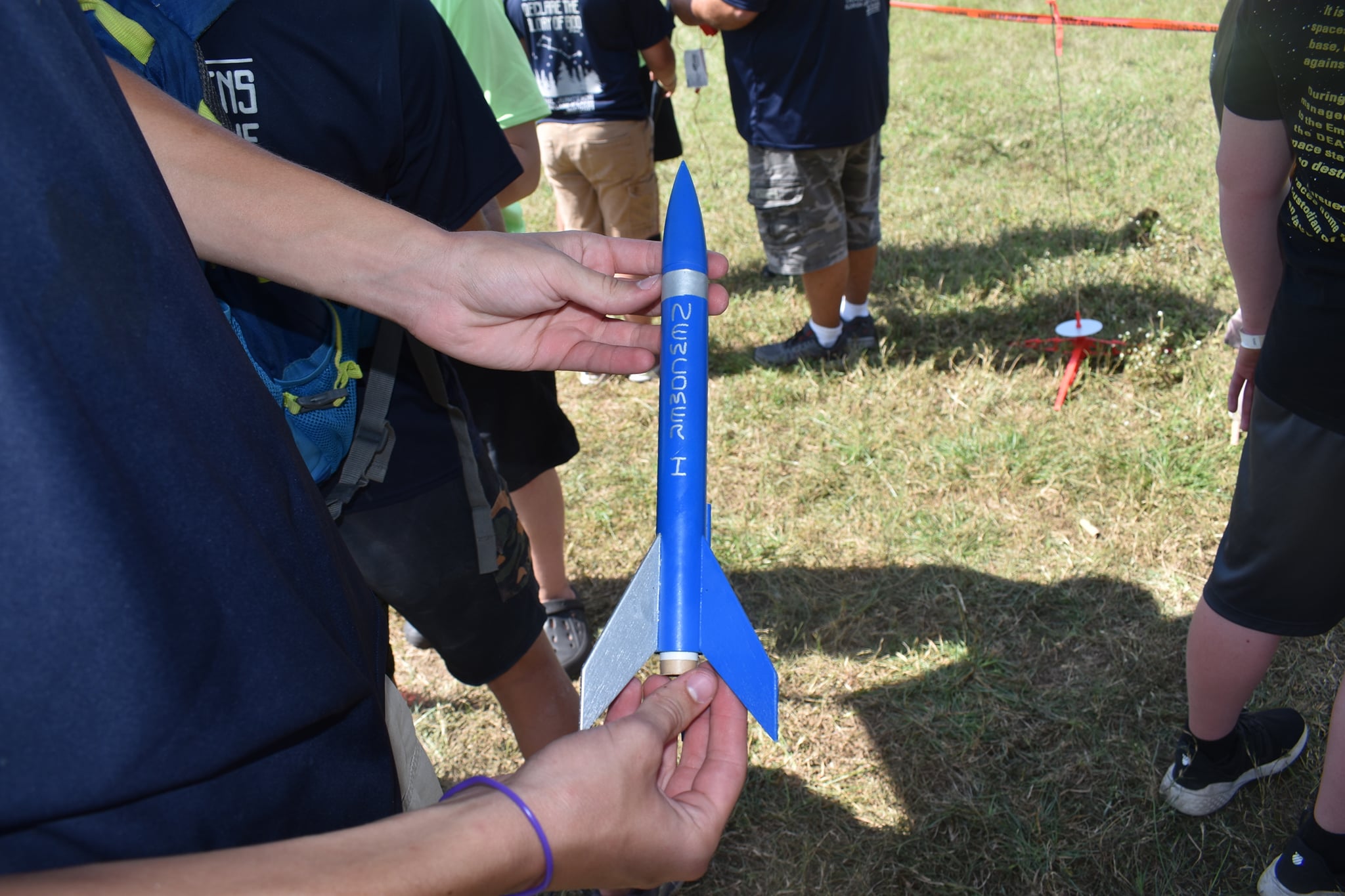
After doing some research, I bought an Estes Alpha rocket from their website. I had concluded that the Alpha was the best rocket for a beginner to start onm, while it still used the same construction techniques implied on more advanced models. This is because eventually I plan to build my own rockets from scratch, not a kit, and Newcomer is supposed to familarize me with the aspects of model rocketry needed to do this. Aong with this purchase was a launch pad, controller and a bag of recovery wadding to bring the total above 50 for a shipping deal.
I worked on completing that Alpha kit, which I named Newcomer I after the first orbital rocket I created in Kerbal Space Program. I came up with the idea for the "program" system and the name Newcomer after naming the rocket newcomer, so I decided the next rocket would be "Newcomer II" and so forth.
I intended to take a theodolite reading for every launch, and use trigonometry to determine the height. Taking highschool physics then, I also wanted to see if I could calculate my rockets' Delta-v. Of course, I would have to assume that there is no wind or drag, and that the engine is providing a constant acceleration, which may not be true, and other assumptions. However, I decided I wasn't going to try to do all this at Trail Junction, so it never happened. I also bought a supply of engines from Estes sometime before Trail Junction.
The 2021 Trail Junction was having a Model Rocketry event, and of course I brought my rocket to use. Mr. Smitty, a leader of our troop, recently retired from NASA, and had a large bin of model rocket kits that he gave out to members of our troop. They were all Estes Alpha Beta Series kits. I ended up recieving three of these kits (one before the event and two from the leftovers) because of my interest in model rocketry (NC-2, NC-3, NC-4).
I launched Newcomer I three times at Trail Junction. The first time I used an B-powered motor. The flight went good with an easy recovery and I was loving it. The second time I used an A or 1/2A engine for somereason. I think I was being cautious, or maybe I just wanted to see it all up close. Point is I remember of of the adult leaders of your troop incouraging me to use a more powerful motor. The third time I used a C engine. It went so high that when the parachutes deployed, it was so high up I lost track of it and it blew beyond the recovery area. I attribute this to to using a powerful engine on a windy day at a very small launch field.

I began work on Newcomer II, one of the kits I received, soon after getting home. This kit and the other two I got were marked as Estes Alpha (Beta Series) kits. They were mostly similar to the kit I bought online, but the most noticable difference is that the Beta Series uses an elestic cord for a shock cord, while the current kit (Newcomer I) uses a rubber band as the shock cord. For Newcomer I, I stuck to the instructions and did everything exactly like they said, but for Newcomer II I made some modifications outside of the instructions. I cut the launch lug to have slanted leading and trailing edges for aerodynamics, and also mounted it next to a fin for the same reason, but it also makes it more stable. I also discovered that because of where I had put the launch lug, the engine hook got in the way of the launch rod and dragged along it all the way up. By placing the launch lug next to a fin, I avoided this aswell. I also painted the nosecone, body tube, and fins separatly before gluing them together, while with NC-1 I assembled the rocket and then spray painted the completed rocket using some paper and masking tape.
I have selected a public park, one our family calls 'Yellow Park' becuae of the color of it's old playground equipment, near our house as a launch site. It is small, but has a field big enough to support A- and possibly B-power launches (I later found out this park actually only supports 1/2A and less). At Trail Junction 2021, I got an understanding of how much area was needed for different power launches, so I know I will need a bigger field to launch higher power engines.
On December 15th, 2021, my brother Adam and I took my gear and Newcomer II to Yellow Park before I had to work at noon. The first two flights were fairly successful as stated on the Newcomer II page. We attempted to use the theodolite however it was very hard to do this while launching and taking multiple videos with only two people. The rocket was also not going perfectly straight up and for such a short flight was probably not going to be to accurate anyway. We recorded the readings anyways.
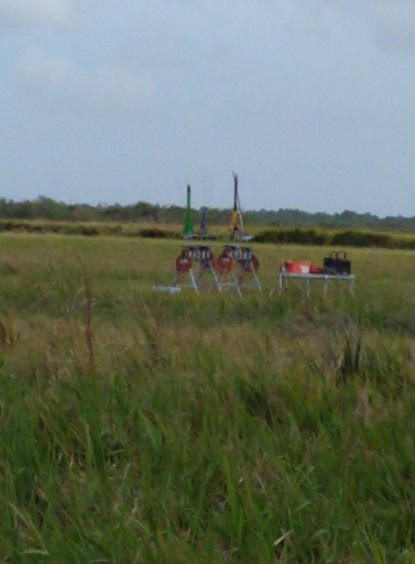
On the third flight, I decided to upgrade to a A-powered motor. I incorrectly remembered the field requirements for an A-powered flight to be 50 feet (the same as 1/4A and 1/2A) when it was in fact 100 feet. It flew much higher than I expected and it landed just past the treeline. We searched for atleast half an hour before we had to start home for me to be back in time for work. It also started raining and we were maybe kinda lost.
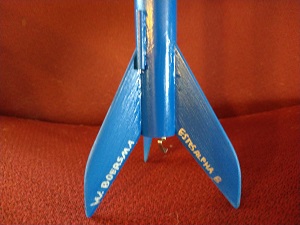
The local model rocketry club, called Spaceport Rocketry Association (SRA) was going to hold their meeting on December 18th, 2021, which I had intended to launch Newcomer II at. Of course, when Newcomer II was lost during a.. um, test accident... I had to quickly build NC-3 in time for the launch. I have to say it looks much better than you would expect from such a hurried assembly. Newcomer 3, the first not to use roman numerals in the name simply because it looked better on the body tube, did take some pointers from Newcomer II. I moved the launch lug (LL) higher up along the body tube to the point recommended in the instructions. When I moved the launch lug to be abreast to the fin with NC-2 I moved it downward so that it would not be sticking past the leading edge of the fin. I did not think to realize that this would make the rocket less stable while on the launch rod since the LL would be farther below the Center of Mass (CoM). I fixed this by simply letting it stick out ahead of the leading edge of the fin. I also didn't bother to cut the ends of the LL for aerodynamics as on NC-2 as I belived this also made it less stable, which the "extra aerodynamics" didn't pay up for.
Newcomer 3 was a great success with 4 flights at the SRA launch, the only hitch being the parachute got tangled and didn't fully deploy during flights two and three. In the next few weeks I joined SRA (I also joined NAR around the time of NC-1, -2.)
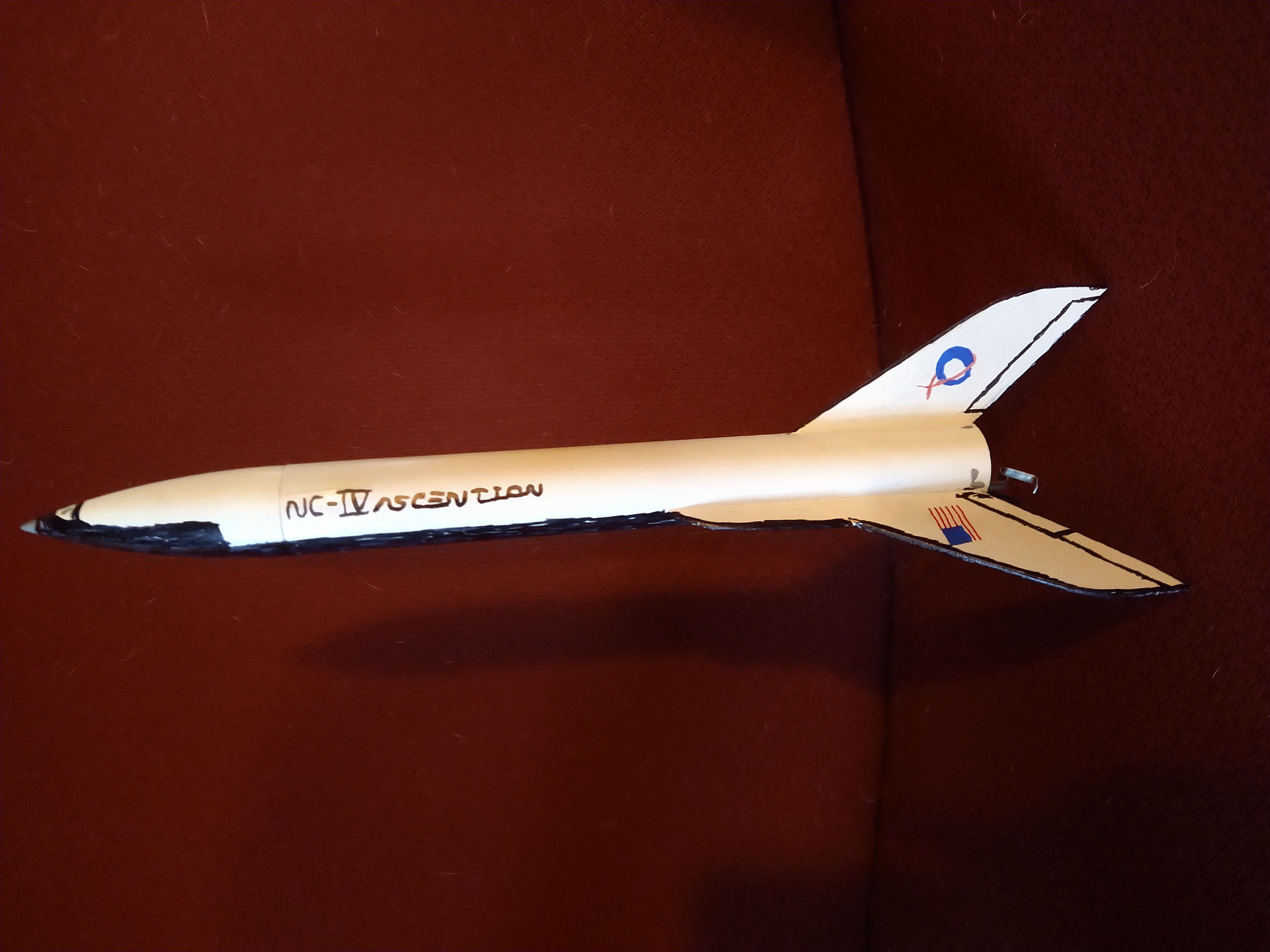
NC-4 Ascension is the first time I made major modifications to the rocket. I cut out strake or chine like fine structures to extend the leading edge of two of the fins just along the body tube. This allowed for the launch lug to be secured to a fin all the way up while not moving it downwards. In fact, I even cut the launch lug in half and put one at the bottom and one at the top on the strake to give better stability off the pad. I also rounded the corner on the leading edge of the fins as on Newcomer 3.
The fin strakes coused the rocket to look like a space shuttle so I painted it white instead of blue and used a black sharpie to color in a bed of silicon tiles, including on the nose tip. I gave it some RCS thruster ports as well (silver sharpie) and EXSA/USA livery. It is defintly my best looking rocket yet.
However the biggest development with NC-4 was adding a detachable parachute system. Instead ofwrapping the parachute lines directly around the nosecone eyelet, I bound them to a aluminum can tab. I then used a small (~1cm diameter) keyring to attach the can tab to the eyelet. This way, I hoped to test NC-4 with different parachutes, the stock one it came with, and a house-built one of smaller diameter for higher flights. This parachut will be made using a shopping bag or another suitable material (maybe both for testing!) I hope to include this feature on all my rockets in the future, as the apparent benefit (easy testing, replacement of parachutes or streamers) seems to excede the small cost (extra weight, which is marginal).
Newcomer 5 is by first non-Alpha model and my first not produced by Estes aswell. The Quest Astra, which I received in an educational kit from Mr. Smitty's donations, served as the fifth Newcomer rocket. I did not originally realize/reemember the educational pack contained a rocket and so I originally thought the three Alpha's were all I got from that, but was happily corrected.
I built Newcomer 5 as similar to Newcomer 3 as the kits allowed. I still included the rounding of the leading corner and launch lug upgrades, but stayed true to the istructions for pretty much everything else. I aimed to test the differences between the two rockets. For this purpose, I did not include my can tab parachute system into NC-5, since it is not present on NC-3, though I doubt it will make a difference.
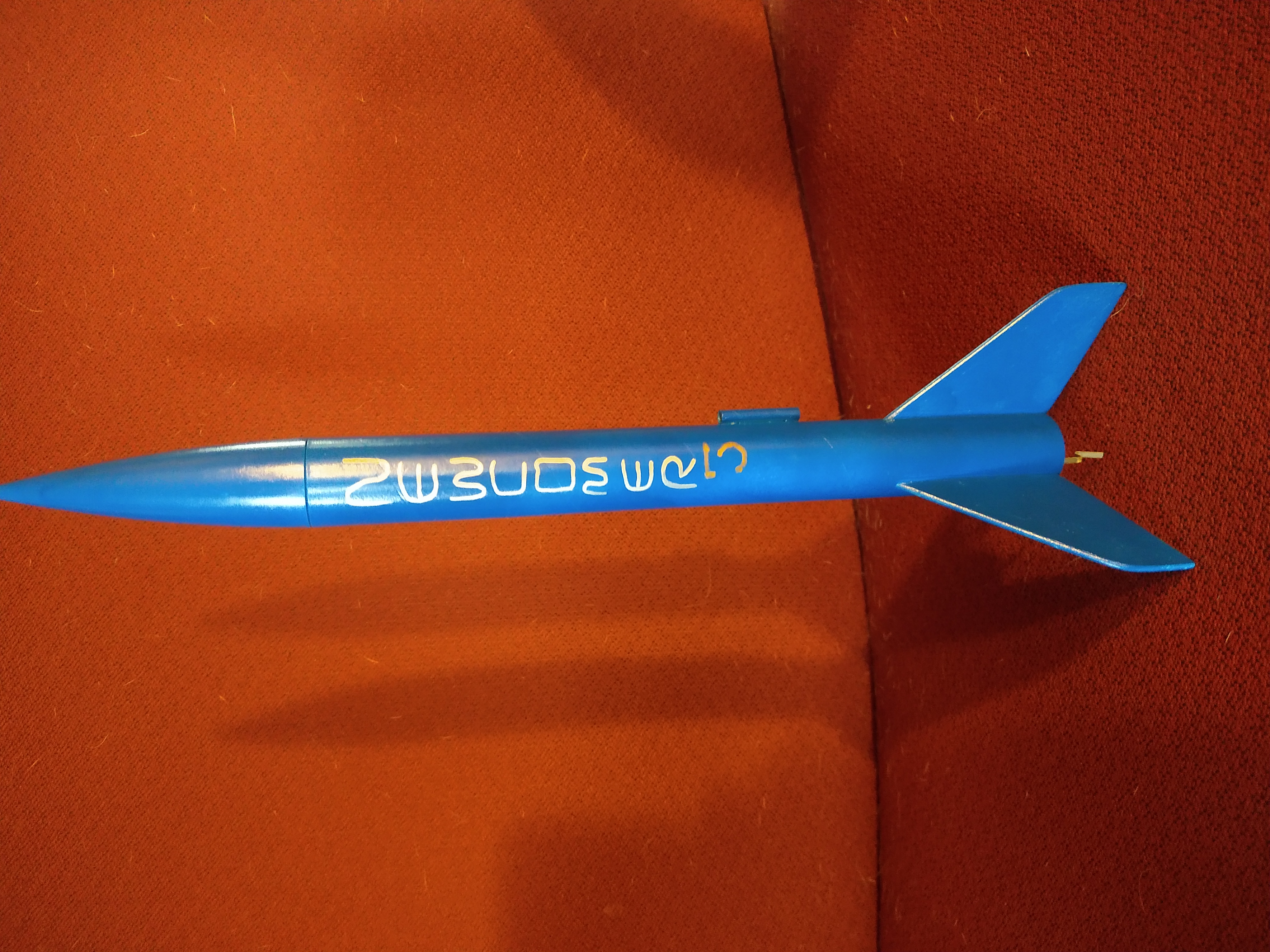
The next rocket launch by the SRA was on January 15th, 2022. However I was swamped with college classes due the following night and had to skip it due to schoolwork. This is possibly a good thing, as I had forgetfully installed the parachute of NC-4 regularily instead of trying my new system (I didn't have a can tab handy at the time). However, I will miss the February launch as I am going on a snorkeling/camping trip to Peanut Island that weekend with Trail Life.
So, I can't launch anything more powerful than a 1/2A until the third saturday of March it seems. I will fly Newcomer 3 and 5 together for joint tests, as well as NC-IV Ascension to test my upgrades and parachute system (which I don't know how it could cause it to fail, but you know). After that, even now, I am beyond the realm of entry level. With 5 rockets under my belt, I hope to step up to more intermediate level rocketry activites, such as higher altitude, dual-deployment of both drogue and main parachtes and scratch-built rocketry soon. I have gained more than just basic experience in construction, launch and recovery of model rockets, however my only attempt at the third triganometry and physics equations goals was abandoned because the low height of the flight, it's not-so-straight-up profile and procimit to the launch pad made me decide to hold off on those goals until a future time. That brings me to call Newcomer a success (regardless of the outcome of Newcomers 3 and 5). I am no longer a newcomer, but a rocketman.
I originally planned for there to be up to three or more Newcomer rockets of other kits to diversify my knowledge. I intended for them to participate in the 'joint tests' with NC-3 and -5 to compare the differences in the kits. I now see that not only would this have wasted time as I am already confident I am capable of moving to more advanced rockets, but I will experience different kits and manufacturers anyway in other projects.
For christmas 2021, I recieved a few kits, including an Estes Baby Bertha. My parents and brother selected it because it looked reminisent of the SpaceX Starship stagecraft, but I realized it was comprable to the Estes Alpha and Quest Astra (Newcomer 3 and 5) and could become "Newcomer 6". I even designed stylized "5" and "6" logos to look similar to the "3" on NC-3. I still used the "5" for Newcomer 5, however, my family gave me pressure saying I should move on from being a "Newcomer" and wanted to see new names. I guess "Newcomer" was gettibng old to them, but to me the iterative process was exciting.
In the end I gave in and realized I really had already acomplished the said goals of Project Newcomer (to learn the basics of construction, launch and recovery of model rockets) and should make a new program. So, Newcomer 5 became the last Newcomer, since I couldn't let go of the 'joint testing' idea and it didn't really fit into a more ambitous program. However my current rocket is a Estes Lunar Scout and isn't a part of a project because I couldn't see how to use it, so it is basically just a little fun stand-alone. I intend to use the "6" on it.
I have actually planned two programs to start, Project Skyshot and Project Ozymandias. Skyshot is simply Newcomer but for bigger D-E power rockets instead of A-C. This is also in preparation for Project Theremin, my ultimate goal to scrtch built bigger rockets. After Skyshot, I would start build small-scale A-C rockets, and then increase in size to D-E powered.
Ozymandias is a much more ambitous program. To Newcomer's Mercury, Ozymandias is Apollo, the ultimate goal behind the line of anticipated capability. The goal is this: "To demonstrate the successful use of onboard quad propellers to land and recover a pyrotechnic model rocket." I say "pyrotechnic" because this has already been done with a pressurized water-based rocket, but more on that on the a Ozymandias page.
I actually did get to launch NC-IV Ascention and Newcomer 5 at the monthly SRA launch on March 19th, 2022. Newcomer 5 was my first launch of the day because I felt like it was less exciting as NC-IV or SKY-1 Raqiya' Xplorer. I felt like the chute was packed a bit tight when I first did it pre-flight, but decided to see what happened and left it. I launched it on a B4-4 with a nominal ascent profile and recovery. It would have been a completly successful flight except for one issue. It turns out one of the tabs on the parachute broke and the string detached from it there. I didn't even notice this until I examined it at our tent after recovery. It seemed to descend under the chute fairly fine, or atleast I didn't notice it during the flight, so it apparently didn't need it too bad. I am not sure if this is related or not, but the tabs also made it harder to pack the chute into the body tube, so they might not be the best method for attaching shrouds. Other than that, the launch went well.
As with my Newcomer 5 Flight 1, I felt that the parachutes may have been packed abit too tight, but it had gone (mostly) well with that flight, and it wasn't really THAT tight. Maybe it had just been a long time since I had launched a rocket and I forgot (it definitely had been a long time since I launched a rocket, or atleast too long). I loaded her with an Estes B4-4 and walked out to the pads. The club director/announcer told me to angle the launch rod straight up instead of angling it, so I did. I now think he was wrong, and think I should have angled into the wind, as all the rockets that did do this were landing much closer; it was a fairly windy day. I want to use smaller parachutes on my rockets from now on to reduce drift. I had thought to bing the UniChute-enabled parachute from the in-construction Ozymandias MVV, however it was bigger than the Alpha's so I didn't use it for fear Ascention would drift even farther away. So, Ascention's second flight used the same parachute.
On her second flight NC-IV launched with a slightly more powerful B6-6 and drifted farther downrange than Flight 1, despite being angled into the wind. However, it wasn't a fuly successful flight. The parachute got a whole burned into it (which wasn't an immediate problem since I had already planned that to me my last flight of the day, but I wouldn't fly it with that parachute again). The recovery wadding was apparently stuck in the shroud lines or something because I found it directly underneath and tangled in them on the ground when I found NC-IV. It had many burnt holes in it, very similar to the one in the parachute, reasonably confirming that the ejection charge blew through the wadding and some got through to the chute. I don't remember how many wads I used, but apparently it wasn't enough it may have been just the one by accident). Anyway, NC-IV is grounded until I can make a new parachute for it. This is actually kind of a good thing as it gives me a chnce to practice making my own chutes and replacing them via the Universal Parachute "UniChute" system.
| Name | Designation | Model | Notes | Status |
|---|---|---|---|---|
| Newcomer I | NC-1 | Estes Alpha | My first rocket, built 100% stock by the instructions (except for paint and decals). Lost at Trail Junction 2021. | Lost |
| Newcomer II | NC-2 | Estes Alpha (Beta Series) | Slight modifications to model. Lost at Yellow Park. | Lost |
| Newcomer 3 | NC-3 | Estes Alpha (Beta Series) | Improvements to modifications from NC-2 data. Successfully launched 4 flights at the December SRA launch. | Active |
| Ascention | NC-4 | Estes Alpha (Beta Series) | Major modifications to base model, fin strakes for liftoff stability. Universal Parachute System first implmented. | Active |
| Newcomer 5 | NC-5 | Quest Astra | Made as similarly to NC-3 as possible to experiment with the differences in the two kits. | Active |
| Newcomer 6 | NC-6 | Estes Baby Bertha | Originally would have joined Newcomer 3 and 5 in similarity tests, but instead used as Ozymandias MVV. | Moved |
| Newcomer VII | NC-7 | TBD | Would have been a unique kit and have joined Newcomer 3 and 5 in similarity tests. | Canceled |
| Newcomer VIII | NC-8 | TBD | Would have been a unique kit and have joined Newcomer 3 and 5 in similarity tests. | Canceled |
Updated 3/23/2022 by William Boersma